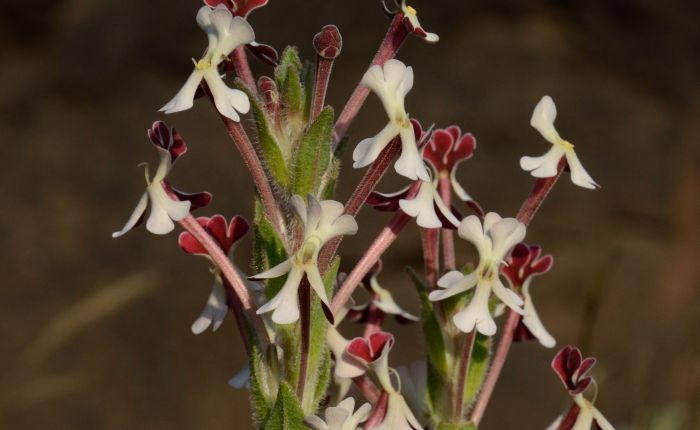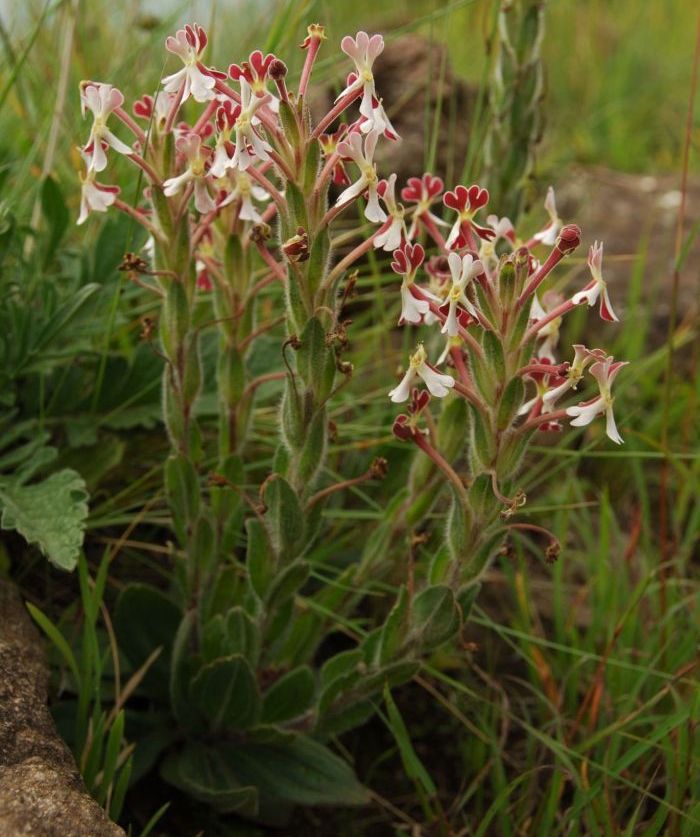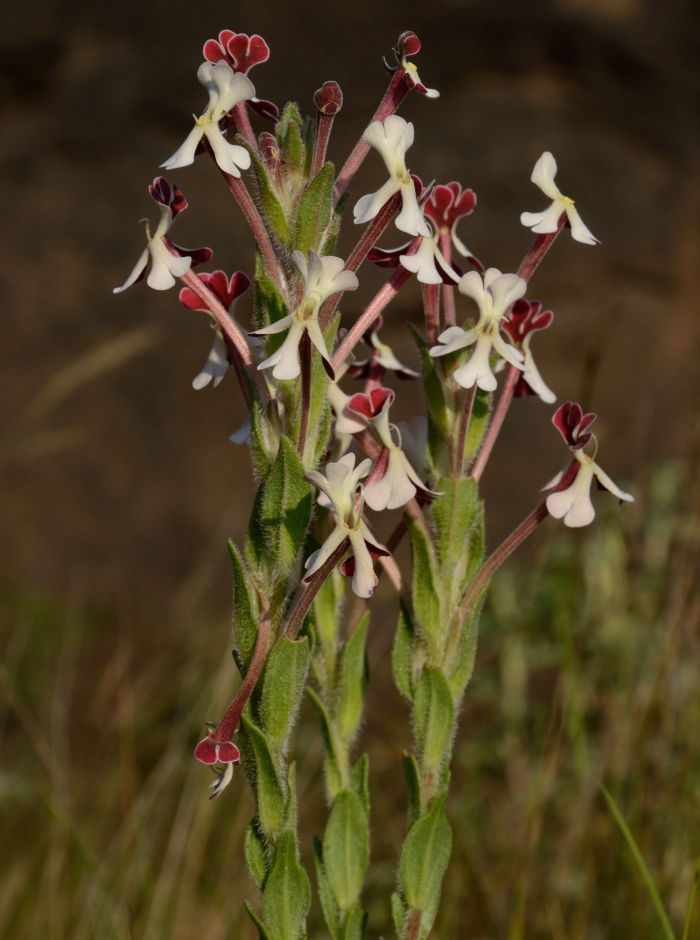Zaluzianskya microsiphon
Zaluzianskya microsiphon (O.Kuntze) K.Schum.
Family: Scrophulariaceae
Common names: two-lipped drumsticks (Eng.); malthungthung (Southern Sotho)
Introduction
A day-flowering species with strongly zygomorphic, unscented flowers.

Description
Description
A perennial herb, with erect stems up to 400 mm tall, covered in soft, downward pointing hairs, with a thick clump of vegetative buds on the crown. Leaves in a basal rosette and up the stem; basal leaves oblanceolate or elliptic, mostly 35–90 × 8–20 mm; stem leaves ascending, elliptic or oblong, mostly 20–65 × 4–9(–20) mm, grading into the floral bracts; margins entire or ± toothed, hairy, at least on margins and midline. Flowers opening during the day; calyx 8–12 mm long, ± hairy; corolla pink, scarlet or crimson outside, creamy or greenish white inside, covered with short gland-tipped hairs, tube (16–)20–40(–52) mm long, limb zygomorphic, held vertically, mouth often hairless, rarely thinly bearded on the side facing the lower lip, lobes deeply notched. Stamens 4, the 2 short anthers usually shortly protruding, and the 2 long anthers either partly included or well exserted. Capsule 12–15 ×4 mm. Flowering takes place in summer, mainly between January and March.

Conservation Status
Status
Zaluzianskya microsiphon is currently assessed as Least Concern (LC) in the Red List of South African plants (Raimondo et al. 2009).
Distribution and habitat
Distribution description
Zaluzianskya microsiphon is most common from Engcobo in the Eastern Cape along the Drakensberg through KwaZulu-Natal and Lesotho to the northeastern Free State, but has also been recorded through the highlands of Mpumalanga, as far as Haenertsburg in Limpopo. It grows in rocky grasslands, between 1 525 and 2 745 m above sea level.
Derivation of name and historical aspects
History
Zaluzianskya was named in honour of Adam Zaluziansky von Zaluzian, 1558–1613, a physician of Prague, author of Methodus herbariae (1592). Zaluziansky seems to have been a deservedly prominent botanist in his day, with some views on taxonomy quite advanced for his time. There is likely no direct connection between him and the species of Zaluzianskya. The specific epithet refers to the very narrow corolla tube (Hepper 1988).
Zaluzianskya is almost endemic to southern Africa, consisting of over 50 species of annual and perennial herbs or almost sub-shrubs, with one species disjunct to the high mountains of East Africa (Heirn 1904; Archibald 2003). Zaluzianskya is widely distributed throughout all the major climatic regions of South Africa, with perennial species common in the eastern summer-rainfall areas, and annual species mainly in the winter-rainfall regions of the Western and Northern Cape (Archibald 2003).
Zaluzianskya microsiphon is allied to Z. natalensis Bernh. and Z. spathacea Walp. These 3 species produce single stems from a mass of undeveloped buds on the crown of the rootstock, and favour open grassy hillsides. Zaluzianskya microsiphon is distinguished from Z. spathacea and Z. natalensis by the corolla limb which is strongly zygomorphic and held vertically, and the flowers which open during the day. Those of Z. natalensis and Z. spathacea in contrast are actinomorphic, held horizontally and open at dusk (Hilliard 1994).

Ecology
Ecology
Johnson et al. (2002) showed that long-tubed flowers in Zaluzianskya section Nycterinia, to which Z. microsiphon belongs, are mostly specialized for pollination by hawkmoths, predominantly Hippotion celerio. The hawkmoths carry large pollen loads (100–3 000 grains) on their proboscides and heads. In sharp contrast, Z. microsiphon with its unique floral traits (zygomorphy, diurnal flowering and the lack of scent), is adapted for pollination by long proboscid flies. Access to the nectar, which accumulates at the base of the long floral tubes, is restricted to these long-proboscid insects.
Even though Z. microsiphon and Z. natalensis have flowers of the same colour and about the same size, hawkmoths strongly prefer the latter, as its flowers are open and fragrant in the evening, and are presented vertically face up to the pollinator, as opposed to horizontally in Z microsiphon. Changing the orientation of Z. natalensis flowers to face horizontally decreased its attraction to hawkmoths (Campbell et al. 2015).
The study by Anderson et al. (2005) confirmed that Z. microsiphon is exclusively, or almost exclusively, pollinated by the long-proboscid fly Prosoeca ganglbaueri belonging to the family Nemestrinideae. Furthermore, flowers of Z. microsiphon in the Drakensberg region appear to be the most important sources of nectar for P. ganglbaueri during a large proportion of its flight season (Anderson et al. 2005).
Unmanipulated and self-pollinated flowers of Z. microsiphon do not produce seeds nor fruits, whereas fruits develop fully by cross-pollination. This shows that this species is self-incompatible, depending on pollinators for seed production. Johnson et al. (2002) speculate that the hairs around the mouth of the corolla tube may be responsible for the production of scent, since they are abundant in the scented night-flowering species of section Nycterinia, but rare in the unscented day-flowering Z. microsiphon. The gland-tipped hairs that cover most of the corolla may serve as a defence mechanism for the plant against herbivores that feed on the flowers, not involved in pollination (Johnson et al. 2002).
Uses
Use
None known.

Growing Zaluzianskya microsiphon
Grow
Hepper (1988) recorded the cultivation of Zaluzianskya microsiphon at the Royal Botanic Gardens, Kew. The species was best grown as a half-hardy annual, although it can survive winter if protected from frost, by panning up under glass in a cool house for 1 or 2 years. Seedlings for panning up or growing the plant outside past the frost season can be prepared by sowing seed in general seed compost, with bottom heat in early spring. The plant is well suited for growth by a free-draining mix and they need full light to flower well, as the corollas open in sunshine. Flowering persists for about 2 months, beginning in July in the northern hemisphere. In order to produce seeds, hand pollination is necessary as the plants rarely produce capsules in cultivation, because of the absence of the specialized pollinator (long proboscid flies). Otherwise plants can be propagated through cuttings, over-wintered in a frost-free house (Hepper 1988).
References
- Anderson, B., Johnson, S.D. & Carbutt, C. 2005. Exploitation of a specialized mutualism by a deceptive orchid. American Journal of Botany 92(8): 1342–1349.
- Archibald, J.K. 2003. Systematics, hybridization, and character evolution within the southern African genus, Zaluzianskya (Schrophulariaceae S.S., Tribe Manuleeae). The Ohio State University.
- Campbell, D.R., Jürgens, A. & Johnson, S.D. 2016. Reproductive isolation between Zaluzianskya species: the influence of volatiles and flower orientation on hawkmoth foraging choices. New Phytologist (2015) 210: 333–342.
- Cron, G.V. & Condy, G. 2009. Zaluzianskya glareosa Scrophulariaceae s.s., tribe Manuleea. Flowering Plants of Africa 61: 118–123.
- Hepper, F.N.. 1988. Zaluzianskya microsiphon, Scrophulariaceae. In The Kew Magazine 5 (1). Basil Blackwell for the Royal Botanic Gardens, Kew.
- Hiern, W.P. 1904. Scrophulariaceae. In Thiselton-Dyer, W.T. Flora capensis 4: 33–354.
- Hilliard, O.M. 1994. The Manuleeae. A tribe of Schrophulariaceae. Edinburgh University Press, Edinburgh. Pp. 460–522.
- Hilliard, O.M. & Burtt, B.L. 1983. Notes from the Royal Botanic Garden Edinburg 41, 1: 1–43.
- Johnson, S.D., Edwards, T.J., Carbutt, C. & Potgieter, C.J., 2002. Specialization for hawkmoth and long-proboscid fly pollination in Zaluzianskya section Nycterinia (Scrophulariaceae). Botanical Journal of the Linnean Society 138: 17–27.
- Raimondo, D. et al. 2009. Red list of South African plants. Strelitzia 25. SANBI (South African National Biodiversity Institute), Pretoria.
- Retief, E. & Herman, P.P.J. 1997. Plants of the northern provinces of South Africa: keys and diagnostic characters. Strelitzia 6. National Botanical Institute, Pretoria.
Credits
Xichavo Mathebula and John Manning
Compton Herbarium
January 2021
Images by John Manning.
Plant Attributes:
Plant Type: Perennial
SA Distribution: Eastern Cape, Free State, KwaZulu-Natal, Limpopo, Mpumalanga
Soil type: Loam
Flowering season: Late Summer
PH:
Flower colour: Red, White, Pink, Cream
Aspect: Full Sun
Gardening skill: Average
Special Features:
Horticultural zones









Rate this article
Article well written and informative
Rate this plant
Is this an interesting plant?
Login to add your Comment
Back to topNot registered yet? Click here to register.